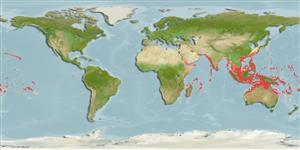Common names from other countries
>
Eupercaria/misc (Various families in series Eupercaria) >
Lutjanidae (Snappers) > Etelinae
Etymology: Aphareus: Greek, aphareys, -eos = water wings under the belly of female tunna (Ref. 45335).
More on author: Lacepède.
Environment: milieu / climate zone / depth range / distribution range
Ecologia
marinhas associadas(os) a recifes; intervalo de profundidade 0 - 122 m (Ref. 9710). Tropical; 35°N - 31°S, 35°E - 134°W (Ref. 55)
Indo-Pacific: East Africa to the Hawaiian Islands, north to southern Japan, south to Australia. Reported from Cocos Island in the eastern Pacific (Ref. 9821).
Tamanho / Peso / Idade
Maturity: Lm ? range ? - ? cm
Max length : 70.0 cm TL macho/indeterminado; (Ref. 5484); common length : 25.0 cm SL macho/indeterminado; (Ref. 9821); peso máx. publicado: 906.00 g (Ref. 4887)
Espinhos dorsais (total) : 10; Raios dorsais (total) : 10 - 11; Espinhos anais: 3; Raios anais : 8.
Adults inhabit inshore coral and rocky reefs and in clear waters of lagoons (Ref. 9821). Pelagic and benthopelagic (Ref. 58302). Occur singly or in small groups. Feed mainly on fishes, but also eat crustaceans. Individuals with brilliant yellow on head may be nuptial males (Ref. 9821). Often curious and approachable (Ref. 9710). Marketed fresh. Minimum depth reported taken from Ref. 128797.
Ciclo de vida ou comportamento de acasalamento
Maturities | Reprodução | Spawnings | Egg(s) | Fecundities | Larvas
Anderson, W.D. Jr. and G.R. Allen, 2001. Lutjanidae. Jobfishes. p. 2840-2918. In K.E. Carpenter and V. Niem (eds.) FAO species identification guide for fishery purposes. The living marine resources of the Western Central Pacific. Vol. 5. Bony fishes part 3 (Menidae to Pomacentridae). FAO, Rome. (Ref. 9821)
Status na Lista Vermelha da UICN (Ref. 130435)
CITES (Ref. 128078)
Not Evaluated
Ameaça para os humanos
Reports of ciguatera poisoning (Ref. 30298)
Uso pelos humanos
Pescarias: espécies comerciais; peixe esportivo: sim
Ferramentas
Relatórios especiais
Baixar XML
Fontes da internet
Estimates based on models
Preferred temperature (Ref.
115969): 24.7 - 29.1, mean 28 (based on 1996 cells).
Índice de diversidade filogenética (Ref.
82804): PD
50 = 0.7500 [Uniqueness, from 0.5 = low to 2.0 = high].
Bayesian length-weight: a=0.01738 (0.01020 - 0.02960), b=2.95 (2.81 - 3.09), in cm Total Length, based on LWR estimates for this species & (Sub)family-body (Ref.
93245).
Nível Trófico (Ref.
69278): 4.1 ±0.73 se; based on food items.
Resiliência (Ref.
120179): médio(a), tempo mínimo de duplicação da população 1,4 - 4,4 anos (tmax = 9).
Fishing Vulnerability (Ref.
59153): Moderate to high vulnerability (48 of 100).
